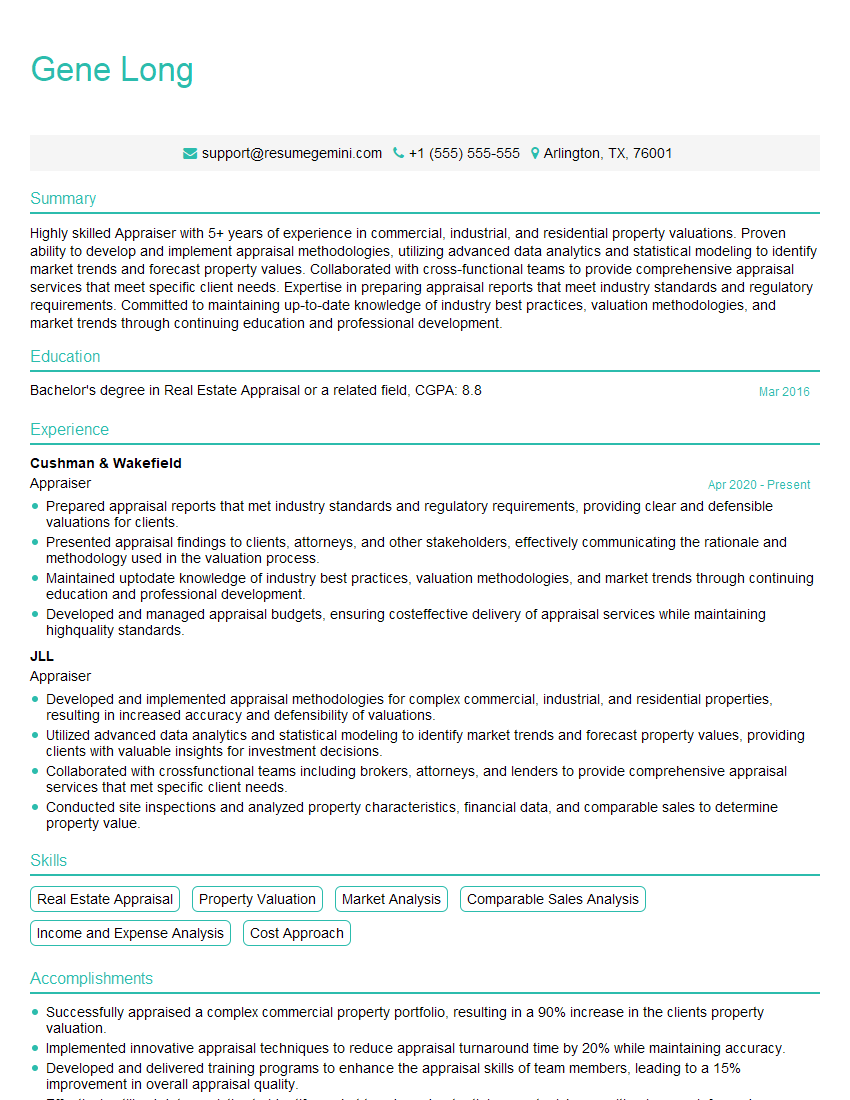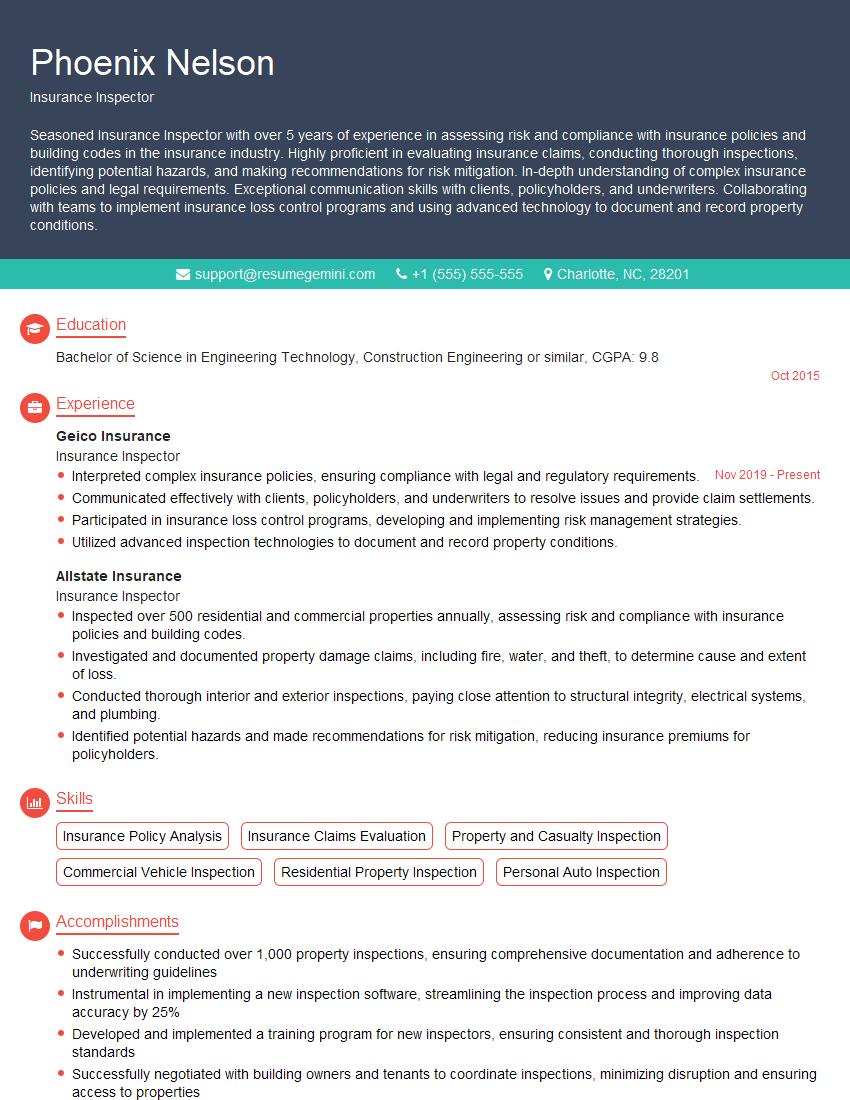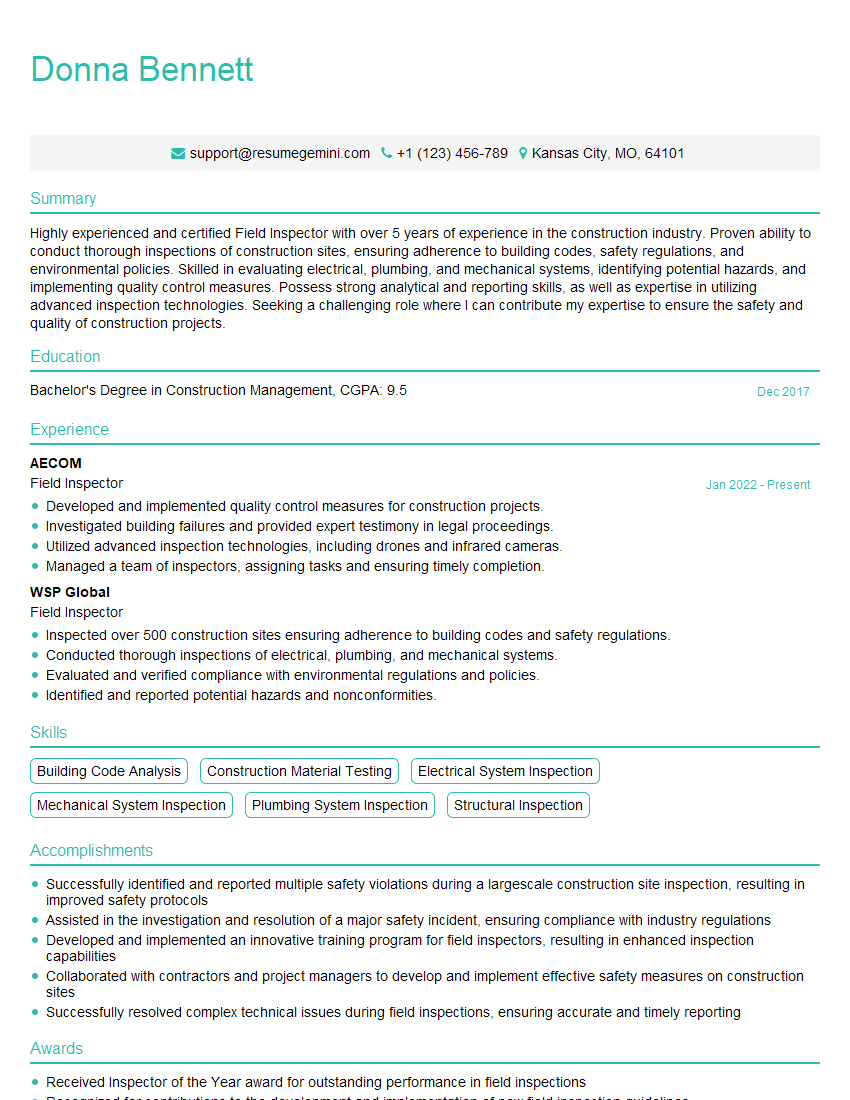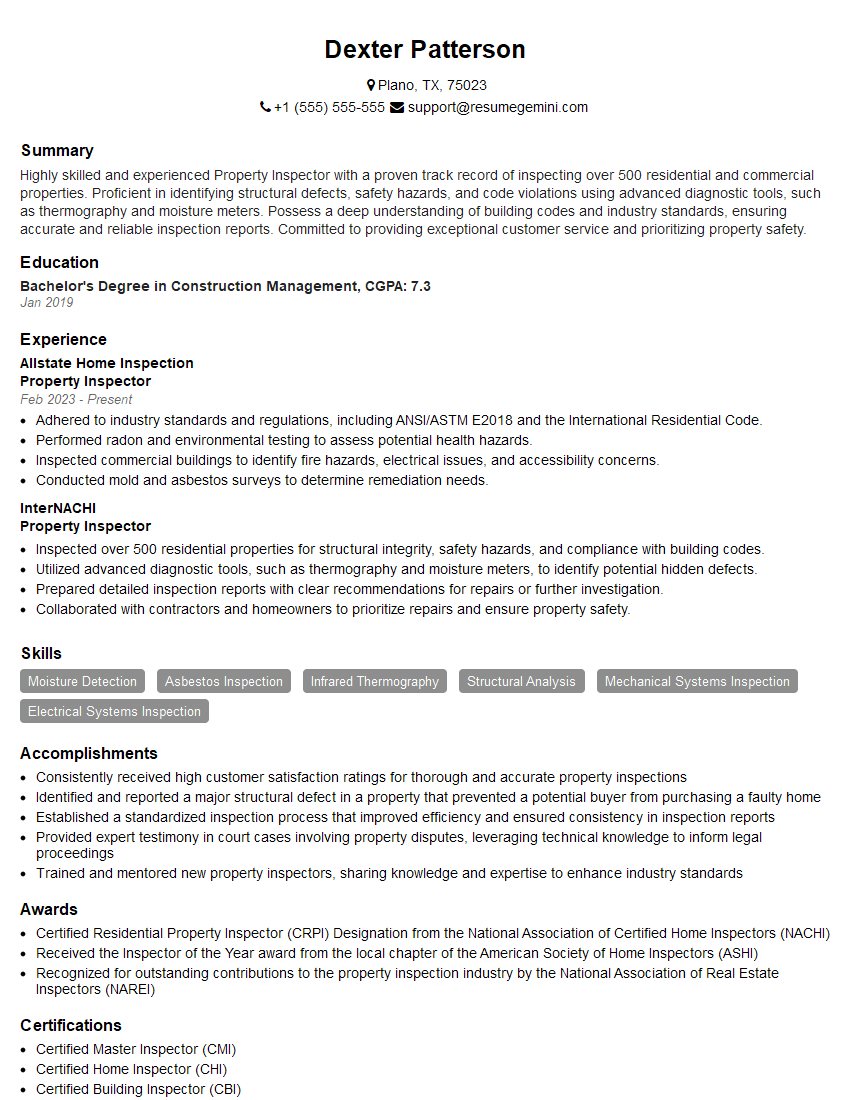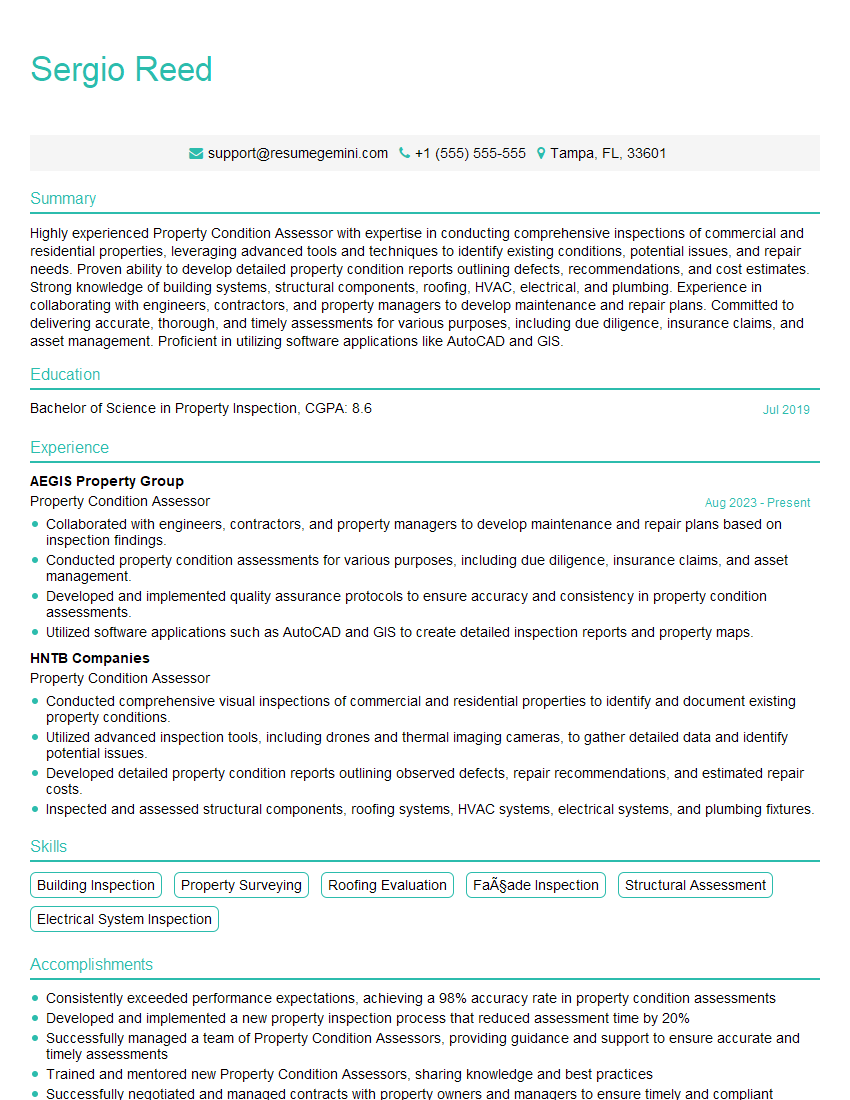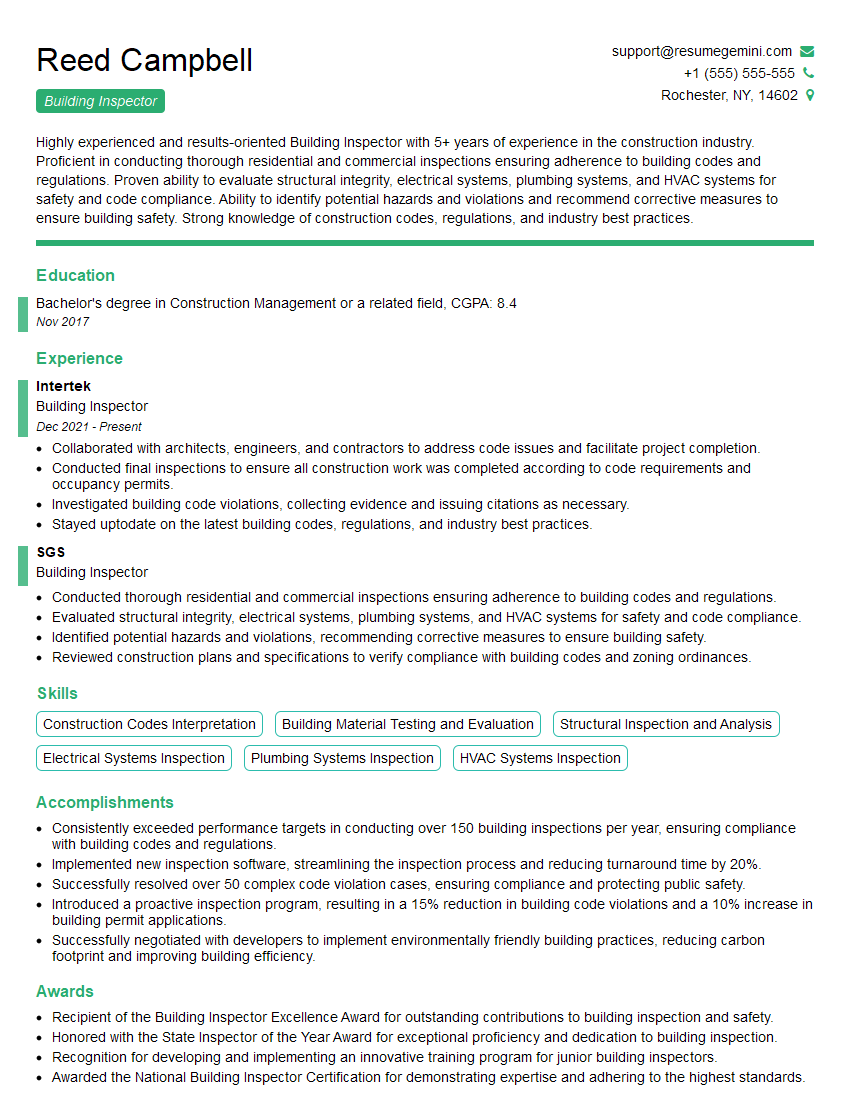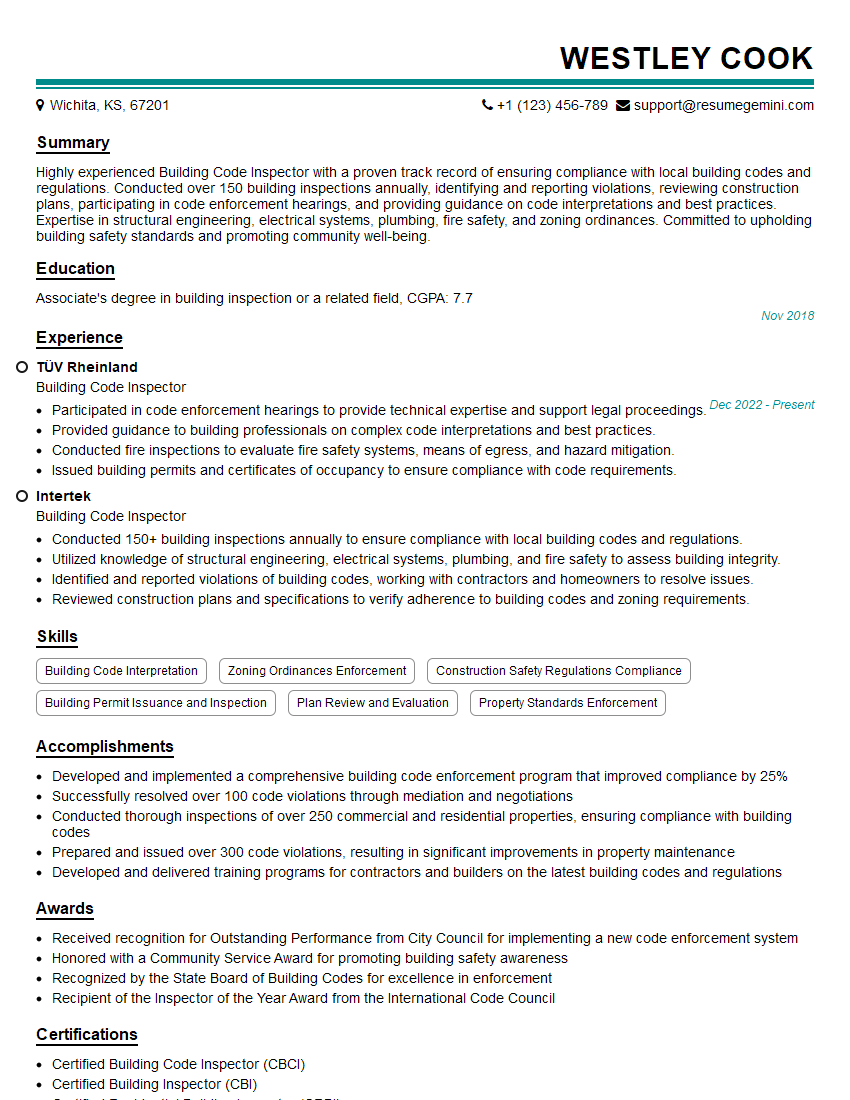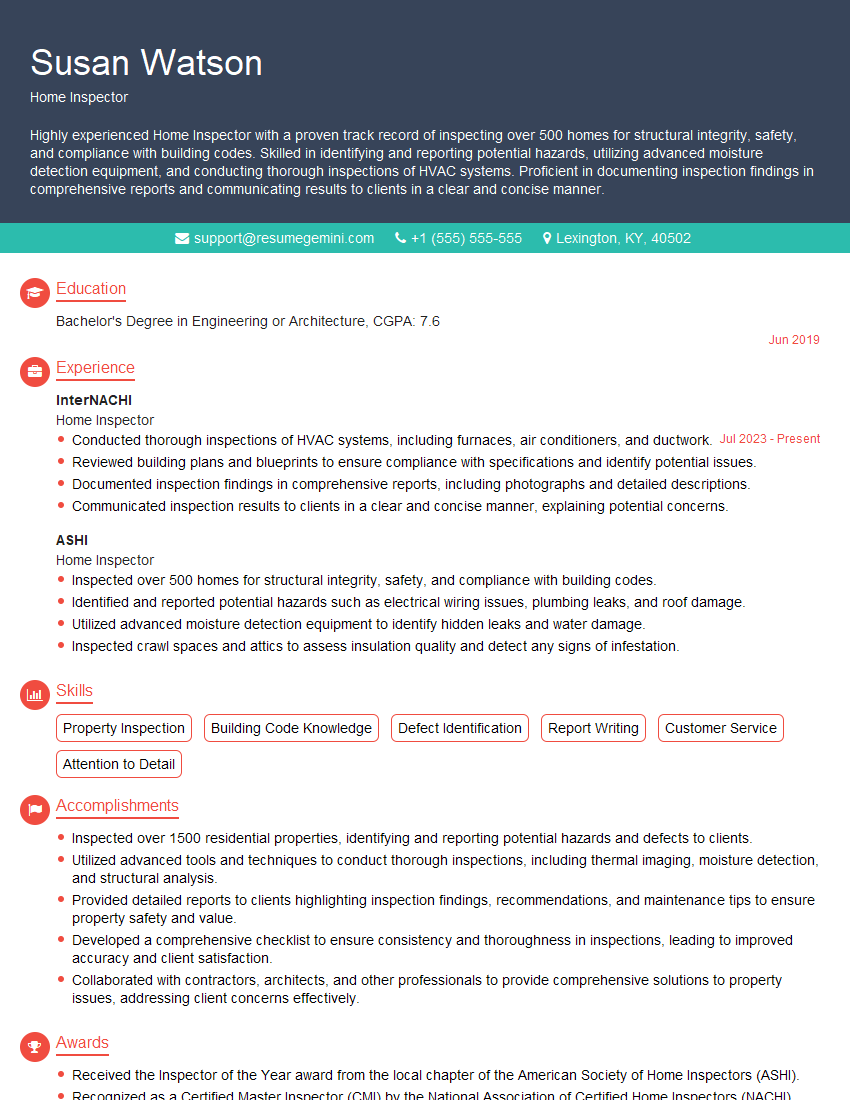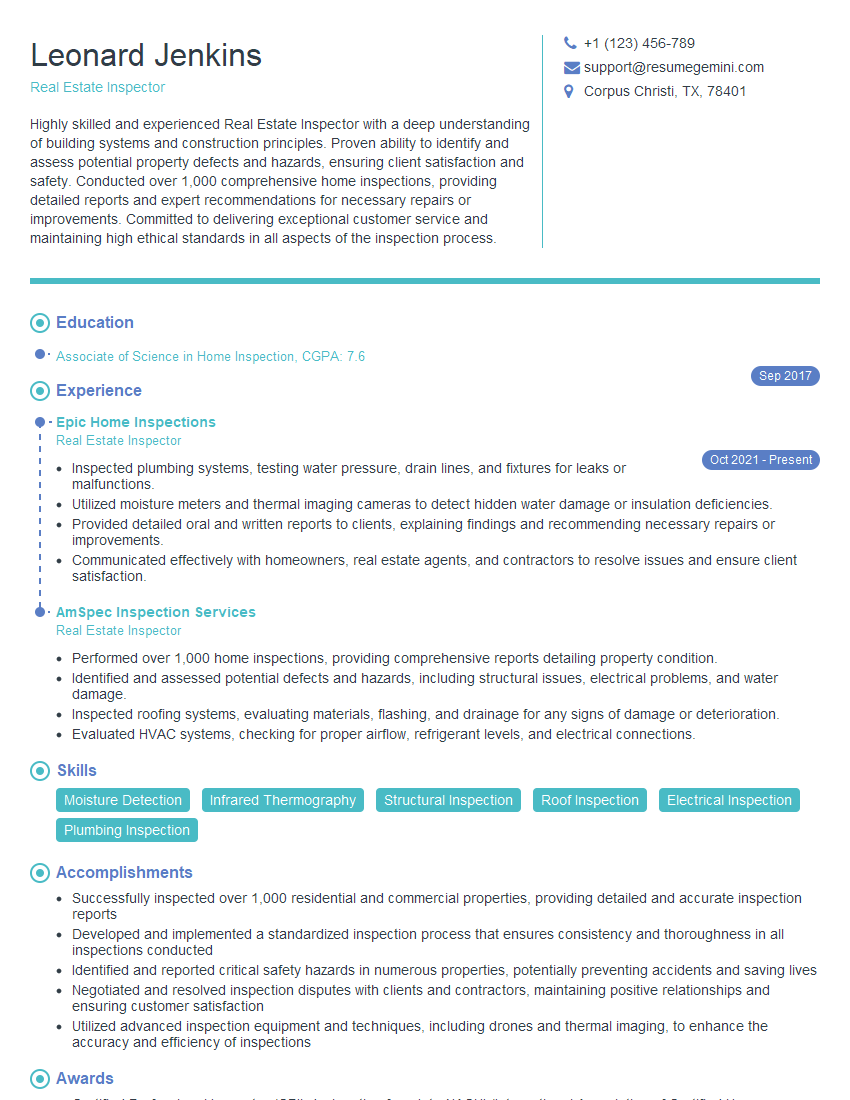Every successful interview starts with knowing what to expect. In this blog, we’ll take you through the top Property Inspection and Reporting interview questions, breaking them down with expert tips to help you deliver impactful answers. Step into your next interview fully prepared and ready to succeed.
Questions Asked in Property Inspection and Reporting Interview
Q 1. Explain your experience with various types of property inspections (residential, commercial, industrial).
My experience encompasses a wide range of property inspections, including residential, commercial, and industrial properties. In residential inspections, I’ve assessed everything from single-family homes to multi-unit dwellings, focusing on structural integrity, plumbing, electrical systems, and HVAC functionality. My commercial inspections have involved office buildings, retail spaces, and restaurants, requiring a deeper understanding of building codes specific to commercial use and tenant safety. Finally, my industrial inspection experience includes factories, warehouses, and manufacturing plants, demanding a keen awareness of safety regulations, hazardous materials handling, and specialized equipment maintenance. Each type presents unique challenges and necessitates a tailored approach.
For example, in a residential inspection, a critical issue might be a leaking roof, impacting the home’s structural integrity. In a commercial setting, a faulty fire suppression system is a far more serious safety hazard. And in an industrial environment, the potential for exposure to hazardous materials is paramount. I adapt my inspection process and reporting to reflect these differences effectively.
Q 2. Describe your process for conducting a thorough property inspection.
My inspection process is systematic and thorough, ensuring comprehensive coverage. It begins with a pre-inspection review of available documents, like blueprints or previous reports, to gain context. Next, I conduct a visual inspection of the property’s exterior, noting the condition of the roof, siding, foundation, and landscaping. Then, I move to the interior, systematically examining each room, paying close attention to structural components, plumbing, electrical systems, HVAC, appliances, and safety features. I use a checklist and take detailed notes and photographs throughout the process. This organized approach ensures that no significant area is overlooked.
Think of it like a doctor’s examination – a systematic check of vital systems, with careful observation and documentation at each step. I also involve the client in the process where appropriate, explaining my findings and answering any questions they might have.
Q 3. How do you identify and document potential safety hazards during an inspection?
Identifying and documenting safety hazards is a critical part of my job. I look for things like exposed wiring, malfunctioning smoke detectors, faulty gas lines, structural weaknesses that could cause collapses, and any signs of water damage that could lead to mold growth. I meticulously document each hazard with photographs and detailed descriptions, specifying its location, nature, and potential consequences. For example, a crack in a foundation wall might be noted with a photo showing the crack’s size and location, alongside a description of its potential impact on the structural integrity of the building and recommended steps for further assessment by a qualified structural engineer. This detail allows clients to understand the severity and potential impact of the issues identified.
I prioritize safety hazards in my reports, clearly highlighting their urgency and potential risk. Safety is always paramount.
Q 4. What software or tools do you use to create detailed inspection reports?
I utilize a combination of software and tools to create comprehensive and detailed inspection reports. My primary software is [Software Name – replace with a real software name, e.g., Spectora, HomeGauge], a specialized platform designed for property inspection reporting. This software allows me to input data efficiently, generate professional-looking reports with images and detailed descriptions, and even create custom templates based on the type of inspection. I also use a high-resolution digital camera and a laser measuring tool to accurately document dimensions and capture clear visual evidence of any observed issues. The software integrates with the camera and measuring tools, streamlining the workflow and reducing the chance of errors.
The software’s reporting features allow me to easily organize findings by severity, system, or any other criteria needed. This ensures the report is both complete and easily understandable for the client.
Q 5. How familiar are you with local building codes and regulations?
I am very familiar with local building codes and regulations. My knowledge is constantly updated through continuing education courses, online resources, and regular review of code updates. I understand that adhering to these codes is critical for ensuring the safety and legal compliance of properties. This includes knowledge of the International Building Code (IBC), as well as any local amendments or specific requirements applicable to the jurisdiction where the inspection is performed. For example, I’m familiar with the specific requirements for fire safety systems, accessibility compliance, and energy efficiency standards in my area.
Staying current on building codes is essential for providing accurate and reliable inspection reports.
Q 6. Explain your approach to dealing with unexpected issues during an inspection.
Unexpected issues during inspections are not uncommon. My approach involves a combination of careful observation, professional judgment, and clear communication. If I encounter something beyond my expertise, for instance, a complex electrical problem, I will clearly document the issue, including photographs and a description of the problem and its potential implications. I will then recommend that the client consult a qualified specialist for further evaluation and remediation. I will clearly document this recommendation in the report and explain the rationale for it.
Transparency and honesty are crucial. The client needs to be informed about any limitations in my ability to assess certain issues. My goal is not only to identify problems but also to guide the client towards appropriate solutions.
Q 7. How do you prioritize findings in your inspection report?
I prioritize findings in my inspection report based on their severity and potential impact. Safety hazards are always at the top, followed by issues that affect structural integrity or could lead to significant financial costs for the client. Issues are categorized with clear labels in the report (e.g., Critical, Major, Minor), providing a visual representation of their relative importance. This prioritization helps clients focus on the most urgent issues first. A well-organized and prioritized report makes it much easier for clients to understand and act on the information provided.
For instance, a critical safety hazard like a faulty gas line would be listed before a minor cosmetic issue like a chipped paint.
Q 8. Describe your experience with different types of property damage (water, fire, etc.).
My experience encompasses a wide range of property damage types, from the most common like water and fire damage to more specialized cases involving mold, pest infestations, and structural issues. Water damage, for instance, can manifest in various ways – from minor leaks causing cosmetic damage to catastrophic flooding resulting in extensive structural compromise. I’m adept at identifying the source of the water intrusion (e.g., faulty plumbing, roof leaks, or foundation cracks), assessing the extent of the damage to building materials (drywall, wood, insulation), and documenting the findings meticulously. Similarly, fire damage assessments require understanding the effects of heat and smoke on different materials, identifying potential hazards like compromised electrical systems, and assessing the need for remediation and restoration services. I’ve worked on cases ranging from small kitchen fires to large-scale building fires, requiring different levels of investigation and reporting.
For example, I once inspected a property after a significant plumbing failure in the second-floor bathroom. The resulting water damage extended through the ceiling below into the kitchen and living room, affecting drywall, flooring, and cabinetry. My report detailed the extent of water damage, identified the source of the leak, and recommended specific remediation steps to prevent further damage and ensure the building’s structural integrity.
Q 9. How do you handle disagreements with clients regarding inspection findings?
Disagreements with clients are handled professionally and transparently. My approach centers on clear communication and a collaborative problem-solving strategy. I start by carefully reviewing the inspection report with the client, explaining my findings in plain language, providing supporting photographic and video evidence. If a discrepancy exists, I’m open to re-examining the area in question. If necessary, I consult industry standards and best practices to clarify any ambiguity. I believe in being objective and unbiased, acknowledging the possibility of overlooking certain aspects. The goal is always to reach a mutual understanding, providing accurate information for informed decision-making. In rare instances where the disagreement persists, I encourage seeking a third-party opinion or mediation.
For instance, I once had a client disagree with my assessment of foundation settling. Through careful explanation, showing them additional photographs of subtle cracks, and explaining relevant building codes, we reached a mutual understanding of the situation. While they still weren’t happy, they understood the basis for my assessment. Transparency and open communication are key in these situations.
Q 10. How proficient are you in using digital cameras and other inspection tools?
I’m highly proficient in using digital cameras and various inspection tools. I use high-resolution cameras to capture detailed images and videos of property conditions, focusing on areas of concern. My equipment includes a wide-angle lens for capturing broader views and a macro lens for close-up shots of small defects. Beyond cameras, I routinely use moisture meters to detect hidden water damage, thermal imaging cameras to identify insulation problems or electrical issues, and drones (where appropriate and legal) to access hard-to-reach areas. I understand the importance of proper image and video annotation to ensure the visual documentation is clear and directly links to specific findings in my reports. My skillset also includes the use of other tools like laser distance meters for accurate measurements and levels to assess the plumb and level of structures.
Q 11. What is your experience with report writing software?
I have extensive experience using several report writing software packages, including [mention specific software names, e.g., Spectra, ReportGen, etc.]. I’m comfortable with various platforms, adapting quickly to new software as needed. My proficiency extends beyond basic report generation to incorporating detailed visuals, creating professional-looking documents that are easy to understand and navigate. I can customize reports to meet specific client requirements and comply with industry standards. This includes generating clear and concise summaries, detailed descriptions of findings, and recommendations for repairs or preventative maintenance.
Q 12. How do you ensure accuracy and completeness in your inspection reports?
Accuracy and completeness are paramount in my inspection reports. My process begins with a thorough pre-inspection planning phase, establishing a clear scope of work and a detailed checklist to ensure nothing is overlooked. During the inspection itself, I meticulously document findings, using both written descriptions and high-quality photographic and video evidence. I use a standardized reporting template to maintain consistency and avoid omissions. Before submitting the report, I perform a rigorous quality check, verifying the accuracy of measurements, descriptions, and the overall coherence of the findings and recommendations. Regular professional development ensures that my practices align with current industry best practices and standards.
Think of it like creating a detailed recipe: each step must be precisely followed to achieve a consistent and accurate outcome. I use a similar approach, ensuring every step from pre-inspection to final review is methodically completed.
Q 13. What is your understanding of liability and insurance related to property inspections?
I understand that liability and insurance are critical aspects of property inspection. I carry professional liability insurance (Errors and Omissions insurance) to protect myself and my clients from potential claims arising from errors or omissions in my inspections or reports. I’m aware of my legal and ethical responsibilities, ensuring that my work is performed diligently, objectively, and adheres to all relevant laws and regulations. This includes adhering to specific disclosure requirements and avoiding making definitive statements about conditions outside my area of expertise. Understanding local building codes and regulations is crucial for ensuring the accuracy and relevance of my findings and recommendations.
Q 14. Explain your knowledge of various building materials and their common defects.
My knowledge of building materials and their common defects is extensive. I’m familiar with the properties of various materials, including wood (different species and their susceptibility to rot, insect infestation), concrete (cracking, spalling, efflorescence), masonry (mortar deterioration, freeze-thaw damage), roofing materials (shingle degradation, flashing leaks), and various types of insulation (moisture absorption, settling). I can identify common defects associated with each material, assess their severity, and provide insightful recommendations for repair or replacement. Understanding material characteristics helps me accurately assess the extent of damage and recommend the most appropriate and cost-effective solutions. For example, recognizing the signs of termite damage in wood framing, or identifying the cause of efflorescence on a brick wall, requires a detailed understanding of the materials themselves and environmental factors that can lead to their degradation.
Q 15. Describe your experience with pest inspections.
Pest inspections are a crucial part of a comprehensive property assessment. My experience encompasses identifying various pest infestations, assessing the extent of damage, and recommending appropriate remediation strategies. This includes recognizing signs of termites, wood-boring insects, rodents, and other common pests. I utilize a variety of techniques, including visual inspections, probing suspicious areas, and reviewing previous pest control reports. For example, I recently inspected a property where I identified subterranean termite activity based on mud tubes along the foundation and frass (insect droppings) in the crawlspace. My report detailed the findings, recommended professional termite treatment, and outlined preventative measures to prevent future infestations. I also understand the importance of accurately identifying the specific pest to ensure the most effective treatment is recommended.
Career Expert Tips:
- Ace those interviews! Prepare effectively by reviewing the Top 50 Most Common Interview Questions on ResumeGemini.
- Navigate your job search with confidence! Explore a wide range of Career Tips on ResumeGemini. Learn about common challenges and recommendations to overcome them.
- Craft the perfect resume! Master the Art of Resume Writing with ResumeGemini’s guide. Showcase your unique qualifications and achievements effectively.
- Don’t miss out on holiday savings! Build your dream resume with ResumeGemini’s ATS optimized templates.
Q 16. How do you handle situations where access to certain areas is restricted?
Restricted access is a common challenge. My approach is always to prioritize safety and legal compliance. I begin by clearly documenting any areas I cannot access in my report, explaining the reasons for the restriction. For instance, if a locked room is suspected to have potential issues, I’ll note this limitation, but also suggest ways to gain access for a more thorough inspection if deemed necessary by the client. In cases where restricted access prevents a complete assessment, I make it clear in my report that my findings are limited to the accessible areas. Furthermore, I always inform the client upfront of any limitations, ensuring transparent communication. If legal considerations are involved, such as areas sealed due to suspected mold or asbestos, I outline the necessary steps required to proceed, emphasizing the need for certified professionals and appropriate safety protocols.
Q 17. Describe a challenging inspection and how you overcame the obstacles.
One particularly challenging inspection involved a historic home with extensive renovations underway. The combination of unfinished work, hidden structural components, and obscured access points made it difficult to assess the structural integrity and the extent of moisture damage. To overcome this, I employed a multi-faceted approach. First, I carefully documented the accessible areas, focusing on visible signs of damage and taking detailed photographs. Secondly, I used specialized tools like moisture meters to detect hidden problems. Finally, I collaborated with the contractor and homeowner to coordinate access to specific areas as the renovations progressed. This involved careful planning and scheduling, ensuring minimal disruption to the project. The final report included detailed observations, limitations due to incomplete renovation, and recommendations for further investigation once certain areas were accessible. The key to success was open communication, a systematic approach, and the willingness to adapt to the dynamic conditions of the project.
Q 18. How do you stay up-to-date on changes in building codes and inspection techniques?
Staying current is paramount in this field. I actively participate in continuing education courses offered by professional organizations such as ASHI (American Society of Home Inspectors) and InterNACHI (International Association of Certified Home Inspectors). I regularly review updated building codes for my region and subscribe to industry publications and online resources that highlight new inspection techniques and technologies. Furthermore, attending industry conferences and workshops allows me to network with other inspectors and learn about best practices from experienced professionals. I also track changes in local legislation regarding environmental issues, ensuring compliance with relevant laws concerning things like lead-based paint and asbestos abatement.
Q 19. Explain your understanding of different types of roofing materials and their maintenance.
Understanding roofing materials is critical. Common types include asphalt shingles (the most prevalent), tile (clay or concrete), metal (standing seam or corrugated), and wood shakes. Each has unique characteristics impacting lifespan and maintenance requirements. For example, asphalt shingles are relatively inexpensive but require periodic inspection for wear and tear; tile roofs are durable but can be prone to cracking from settling, requiring occasional repairs; metal roofs are extremely durable but may require specialized tools and techniques for maintenance. My inspections assess the condition of the roofing material, flashing, underlayment, and gutters, noting any signs of damage, leaks, or wear. I advise on necessary repairs or preventative maintenance, such as cleaning gutters, addressing damaged flashing, or replacing aging shingles. The report details the findings and provides recommendations for repair or replacement, accounting for the type of material used and its expected lifespan. For example, a homeowner with a 20 year old asphalt shingle roof might need a partial or full replacement sooner than someone with a newer metal roof.
Q 20. What is your experience with foundation inspections?
Foundation inspections require a thorough understanding of structural mechanics and potential problems. I assess foundations for cracks, settling, bowing walls, and water damage. My process involves a visual inspection of the foundation’s exterior and interior (if accessible), looking for signs of distress. I also check for proper drainage around the foundation, looking for signs of water accumulation that could lead to damage. Specialized tools, such as moisture meters, may be used to detect hidden moisture problems. I am experienced with various foundation types, including concrete slabs, crawl spaces, and basements. My report details the findings, including measurements of cracks or settling, and recommends appropriate action, ranging from simple repairs to major structural work. If I identify significant issues that are beyond my expertise, I advise the client to consult with a structural engineer.
Q 21. How familiar are you with electrical systems and their potential safety issues?
While I am not a licensed electrician, I possess a working knowledge of electrical systems sufficient for a property inspection. I can identify obvious safety hazards, such as exposed wiring, faulty outlets, overloaded circuits, and malfunctioning electrical panels. I look for signs of overheating, such as discolored wiring or burned outlets. I cannot, however, test the functionality of the electrical system beyond basic visual inspection. If I identify a potential issue, I clearly document it in my report and strongly advise the client to engage a qualified electrician for a thorough evaluation and repair. My goal is to ensure the safety of the homeowner while acknowledging the limits of my expertise. For example, if I find a frayed wire behind a loose receptacle, I will clearly note this and recommend that it be inspected by a licensed electrician immediately as this poses a fire risk.
Q 22. Describe your understanding of plumbing systems and common problems.
Plumbing systems are the veins of a building, responsible for the safe and efficient distribution of water and the removal of wastewater. My understanding encompasses the entire system, from the water main connection to fixtures and drainage. Common problems I frequently encounter include:
- Leaks: These can range from minor drips in faucets to major leaks in pipes, potentially causing significant water damage and structural issues. Identifying the source, often using tools like pressure testing, is crucial.
- Clogged drains: Hair, grease, and other debris can accumulate, leading to slow drainage or complete blockages. Understanding the layout of the drainage system helps in effective troubleshooting and clearing.
- Low water pressure: This can stem from a variety of issues, including sediment buildup in pipes, faulty valves, or problems with the water main. A systematic approach, checking pressure at various points, is necessary.
- Water heater malfunctions: Issues such as leaks, insufficient hot water supply, and safety concerns like lack of pressure relief valve functionality are common and require careful inspection.
- Fixture failures: Toilets, sinks, and showers can develop leaks or malfunctions due to wear and tear, corrosion, or mineral buildup. Identifying the cause and recommending appropriate repairs is crucial.
I always assess the condition of pipes – looking for signs of corrosion, rust, or leaks – and check the functionality of all fixtures to ensure they operate efficiently and safely.
Q 23. How do you identify signs of mold or water damage?
Identifying mold and water damage requires a keen eye and methodical approach. Signs of mold often include discoloration (black, green, gray, or brown stains), a musty odor, and a slimy or spongy texture on surfaces. Water damage may manifest as:
- Discoloration on walls or ceilings: Water stains are often a clear indicator, even if the source is long gone.
- Blistering or peeling paint: Water absorption by paint and drywall causes it to lose adhesion.
- Bulging or sagging drywall: This indicates significant water absorption behind the wall surface.
- Soft or spongy areas on walls or floors: This signifies rotted wood or water-damaged materials.
- Musty or mildew odor: A strong, unpleasant smell often accompanies mold growth and water damage.
I use a moisture meter to quantify the level of moisture in suspect areas, providing objective evidence of water damage. If mold is suspected, I recommend a professional mold assessment, as certain types can be hazardous to health.
For example, during a recent inspection, I noticed slight discoloration on a ceiling in a bathroom. Using a moisture meter, I confirmed elevated moisture levels, indicating a likely leak in the plumbing above. This was further confirmed upon investigation of the shower unit revealing a small crack in the caulking.
Q 24. How experienced are you with HVAC systems and their components?
I possess extensive experience working with HVAC systems, covering all major components. This includes:
- Furnaces: I inspect gas and electric furnaces for proper operation, checking for gas leaks, burner efficiency, safety controls, and the integrity of heat exchangers. I always prioritize safety and ensure that all safety devices function correctly.
- Air conditioners: I assess the cooling capacity, refrigerant levels, compressor function, and the overall condition of the condenser and evaporator coils. Cleanliness and proper airflow are key aspects I evaluate.
- Heat pumps: I inspect these versatile systems, evaluating both their heating and cooling modes, considering the efficiency and effectiveness of the heat exchange process.
- Ductwork: I check for leaks, proper insulation, and adequate airflow in the duct system. Properly sealed ductwork improves system efficiency and air quality.
- Thermostats: I confirm that the thermostats are functioning correctly, maintaining the desired temperature settings.
My experience enables me to identify potential problems, such as refrigerant leaks, inefficient operation, or safety hazards. I can clearly articulate my findings in my reports to facilitate effective communication with clients and contractors.
Q 25. What is your process for verifying the structural integrity of a building?
Verifying structural integrity requires a thorough assessment, going beyond a visual inspection. My process includes:
- Visual inspection: I carefully examine the foundation, walls, roof, and other structural elements for cracks, settling, leaning, or other visible signs of damage. I look for signs of water damage which could compromise structural integrity.
- Foundation assessment: I look for cracks in the foundation walls, uneven settling, or evidence of water intrusion. I may use a level to check for unevenness.
- Wall and roof inspection: I inspect the framing, sheathing, and exterior cladding for signs of rot, damage, or inadequate bracing.
- Checking for signs of pest infestation: Termites or other pests can weaken the structure, and I always check for evidence of their presence.
- Reviewing relevant documentation: Where available, reviewing permits, building plans, and previous inspection reports provides valuable context.
While I don’t perform load-bearing tests or complex engineering analyses, my observations and photographic documentation provide a comprehensive assessment of the building’s structural condition and inform clients if further professional investigation is needed.
For example, I recently found slight bowing in an exterior wall during a routine inspection, leading me to recommend a structural engineer’s assessment to determine the severity and potential need for repair.
Q 26. How do you handle clients who are unhappy with your findings?
Handling unhappy clients requires diplomacy, empathy, and a commitment to transparency. My approach focuses on:
- Active listening: I patiently listen to their concerns, allowing them to fully express their dissatisfaction. I show genuine empathy for their perspective.
- Reviewing the findings: I thoroughly review my report and the inspection process, double-checking my observations and ensuring the clarity of my explanations.
- Clear and respectful communication: I clearly explain my methodology, the evidence behind my findings, and the rationale for my conclusions in a calm and respectful manner.
- Offering solutions: I actively work with the client to find appropriate solutions, either by clarifying ambiguities, suggesting further investigations, or providing contact information for relevant specialists.
- Professional documentation: All client interactions and follow-up actions are diligently documented.
It’s essential to remember that professionalism and clear communication are paramount in resolving any misunderstandings. Sometimes a simple explanation or clarification can greatly improve satisfaction.
Q 27. Describe your experience working independently and as part of a team.
I’m equally comfortable working independently and collaboratively. My independent work involves planning and executing inspections, meticulously documenting findings, and composing comprehensive reports. My strong organizational skills and attention to detail enable me to manage multiple projects simultaneously and deliver high-quality work within deadlines. This independence is crucial for efficiently covering a large number of inspections.
Collaborative work often involves participating in team discussions to share observations, insights, and potential solutions to complex issues. This teamwork helps in cross-referencing findings, ensuring comprehensive coverage, and learning from others’ expertise. For example, collaborating with contractors or engineers on complex projects allows for a more thorough and comprehensive evaluation.
Q 28. How do you manage your time and prioritize tasks effectively during busy periods?
During busy periods, efficient time management and task prioritization are critical. My strategy revolves around:
- Detailed scheduling: I utilize a digital calendar to schedule inspections, allocate time for travel, reporting, and administrative tasks. This provides a clear overview of my workload.
- Prioritization matrix: I prioritize tasks based on urgency and importance, focusing first on time-sensitive and high-impact activities. This ensures that the most critical inspections and reports are completed first.
- Batching similar tasks: I group similar tasks together to improve efficiency. For example, I’ll conduct all my inspections in one area on a particular day, minimizing travel time.
- Time blocking: I allocate specific time slots for distinct activities, avoiding task-switching and maximizing focus. This technique enhances productivity and reduces interruptions.
- Regular review and adjustments: I frequently review my schedule and adjust it based on changing priorities and unforeseen circumstances. Flexibility is crucial for managing unexpected events.
By using these strategies, I can consistently meet deadlines, maintain high quality in my work, and prevent feeling overwhelmed even during periods of high demand.
Key Topics to Learn for Property Inspection and Reporting Interview
- Property Condition Assessment: Understanding how to accurately assess the physical condition of a property, including structural elements, systems (HVAC, plumbing, electrical), and finishes. Practical application: Knowing how to document and photograph defects effectively and efficiently.
- Report Writing & Documentation: Mastering the art of clear, concise, and comprehensive report writing. This includes utilizing appropriate terminology, presenting findings objectively, and adhering to industry standards. Practical application: Creating reports that are easy to understand for clients, lenders, or other stakeholders, while also being legally sound.
- Legal and Ethical Considerations: Familiarizing yourself with relevant laws, regulations, and ethical standards related to property inspections and reporting, including disclosure requirements and liability. Practical application: Knowing your limitations and when to refer issues to specialists.
- Technology & Software Proficiency: Understanding and demonstrating proficiency with relevant software and technologies used in property inspections and reporting, such as inspection software, digital photography, and report generation tools. Practical application: Utilizing technology to streamline workflows and enhance reporting accuracy.
- Client Communication & Professionalism: Developing strong client communication skills, including active listening, clear explanations of findings, and professional conduct throughout the inspection process. Practical application: Building rapport with clients and handling challenging situations effectively.
- Problem-Solving & Critical Thinking: Identifying potential issues, analyzing their causes, and proposing solutions within the context of property inspections and reporting. Practical application: Analyzing inspection data to determine the significance of findings and recommending appropriate actions.
Next Steps
Mastering Property Inspection and Reporting opens doors to exciting career opportunities and professional growth. A strong understanding of these key areas will significantly increase your interview success rate. To boost your job prospects, crafting an ATS-friendly resume is crucial. ResumeGemini is a trusted resource that can help you build a professional resume that stands out. They provide examples of resumes tailored to Property Inspection and Reporting to help you get started. Take advantage of these resources to showcase your skills and experience effectively and land your dream job.
Explore more articles
Users Rating of Our Blogs
Share Your Experience
We value your feedback! Please rate our content and share your thoughts (optional).
What Readers Say About Our Blog
Hi, I’m Jay, we have a few potential clients that are interested in your services, thought you might be a good fit. I’d love to talk about the details, when do you have time to talk?
Best,
Jay
Founder | CEO
